
Creating a horse grooming routine is essential for maintaining your horse's health and happiness. Start by understanding your horse's specific grooming needs based on its breed and lifestyle. You'll want to gather the right tools and establish a consistent schedule. Each step of the grooming process not only cleans but also strengthens your bond. Knowing how to address hoof care and seasonal changes will enhance your routine even further. Let's explore how to put this all together effectively.
Key Takeaways
- Assess your horse's unique grooming needs based on breed, age, and activity level to tailor the routine effectively.
- Establish a consistent grooming schedule, considering season, activity, and coat type for optimal health and maintenance.
- Begin grooming with a curry comb to loosen dirt, followed by a stiff brush to remove debris from the coat.
- Use soft brushes for sensitive areas and inspect for skin issues, ensuring to check mane, tail, and underbelly regularly.
- Incorporate coat conditioning products and monitor your horse's reactions to enhance comfort and strengthen your bond during grooming.
Understanding Your Horse's Grooming Needs
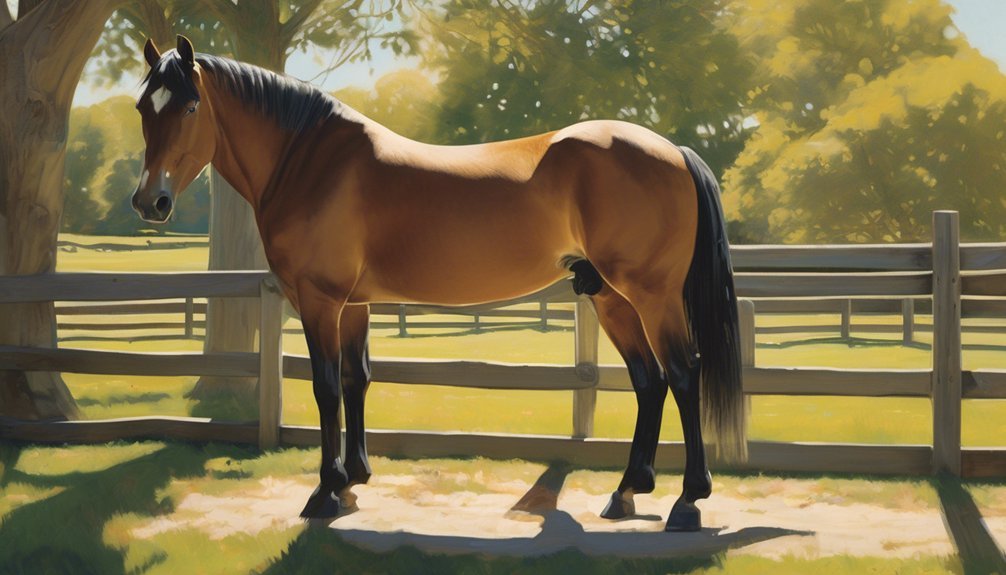
Every horse has unique grooming needs that can vary based on factors like breed, age, and activity level. Understanding your horse's behavior plays a crucial role in determining these needs.
For instance, a younger horse may require more frequent grooming to encourage bonding and build trust. Pay attention to your horse's grooming preferences, as some may enjoy a certain brush or technique while others might be sensitive to touch.
Tailoring your routine to their specific likes not only enhances their comfort but also strengthens your relationship. Always observe their reactions during grooming sessions, as this can provide insight into their mood and preferences, ensuring that the experience is both enjoyable and beneficial for you both.
Essential Grooming Tools to Have
When it comes to grooming your horse, having the right tools on hand is essential for effective care and maintenance.
Start with grooming brushes; a stiff brush removes dirt and debris, while a soft brush is perfect for sensitive areas like the face. A curry comb helps to loosen hair and stimulate your horse's skin, enhancing circulation.
You'll also need a good hoof pick to keep those hooves clean and free of rocks or debris, which is crucial for preventing infections.
Additionally, consider having a mane and tail comb to detangle without causing discomfort.
With these essential grooming tools, you'll not only keep your horse looking beautiful but also strengthen your bond through regular, attentive care.
Establishing a Grooming Schedule
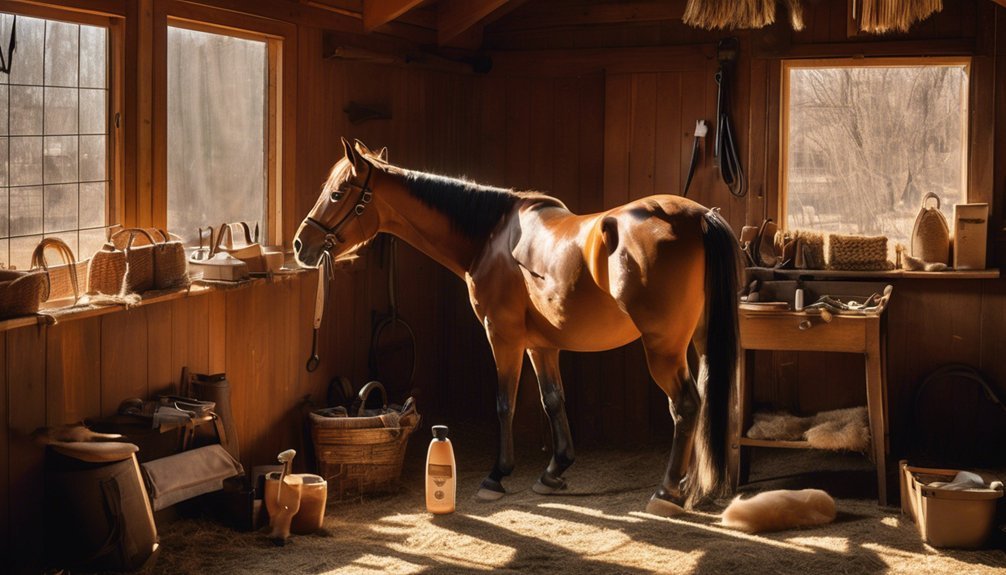
To ensure your horse remains healthy and well-groomed, establishing a consistent grooming schedule is crucial. Start by determining your horse's grooming frequency; many owners find that a daily routine works best, but adjust according to your horse's needs and lifestyle.
Consider factors like the season, activity level, and your horse's coat type.
Scheduling flexibility is key, too. Life can be unpredictable, so allow yourself to adapt the routine when necessary. If daily grooming isn't possible, aim for at least a few times a week.
Whatever schedule you choose, consistency builds trust and helps you notice any changes in your horse's coat or skin. Ultimately, a tailored grooming schedule strengthens your bond and keeps your horse looking its best.
Basic Grooming Steps for a Healthy Coat
A consistent grooming schedule sets the stage for a healthy coat, but knowing the basic grooming steps is just as important.
Start with a good curry comb to loosen dirt and debris, using circular motions. Next, switch to a stiff-bristled brush to remove the loosened particles, working from neck to tail.
Pay attention to sensitive areas like the face and legs, using softer brushes. Incorporate coat conditioning products to add shine and moisture, especially in dry weather.
Finish with a thorough inspection for any skin issues or parasites. Remember, your horse's coat reflects their overall health, so these brushing techniques not only keep them looking great but also strengthen your bond through daily care and attention.
Paying Attention to Hoof Care
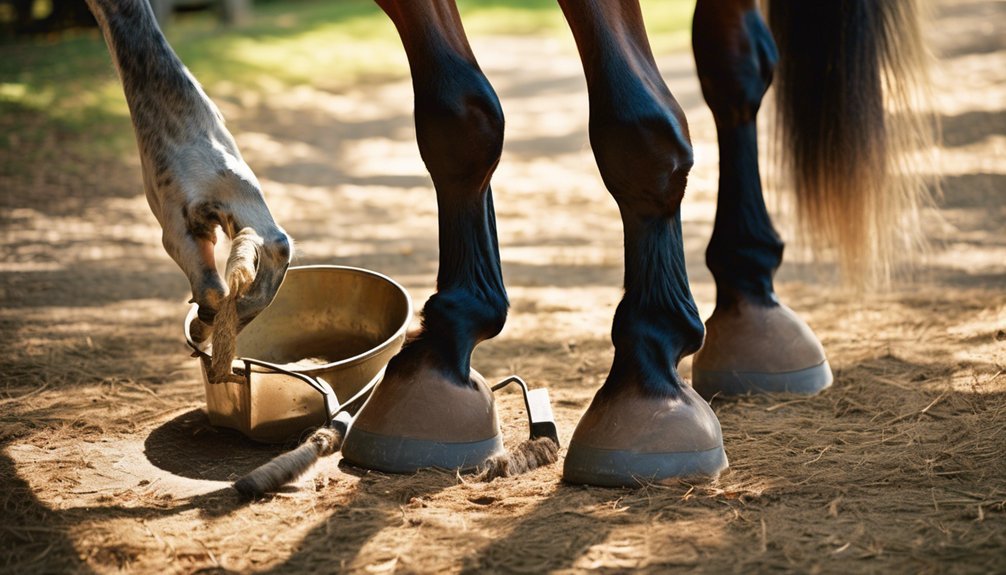
Four vital aspects of hoof care can significantly impact your horse's overall health and performance. Prioritize regular hoof inspections to catch any issues early. Look for cracks, stones, or signs of thrush. Next, maintain a consistent hoof trimming schedule, usually every 6-8 weeks, to promote proper growth and balance. Don't forget to clean the hooves daily; this helps prevent infections and allows you to inspect for abnormalities. Lastly, consider your horse's environment—soft ground may require different care than hard surfaces.
| Aspect | Importance | Frequency |
|---|---|---|
| Hoof Inspection | Detect issues early | Daily |
| Hoof Trimming | Maintain balance and growth | Every 6-8 weeks |
| Cleaning Hooves | Prevent infections | Daily |
Bonding With Your Horse During Grooming
After ensuring your horse's hooves are well cared for, grooming becomes an excellent opportunity to strengthen your bond with your equine companion.
As you brush and pamper your horse, focus on creating a calm and enjoyable atmosphere. This is the perfect time for trust building; your gentle touch reassures them.
Incorporate grooming games, like asking your horse to lift a leg or turning their head to you, to make the experience interactive and fun.
- Speak softly to them throughout the process
- Take your time, enjoying each moment
- Offer treats to reinforce positive behavior
- Use grooming as a chance to check for any skin issues
These efforts foster a deeper connection and mutual understanding between you and your horse.
Seasonal Grooming Considerations
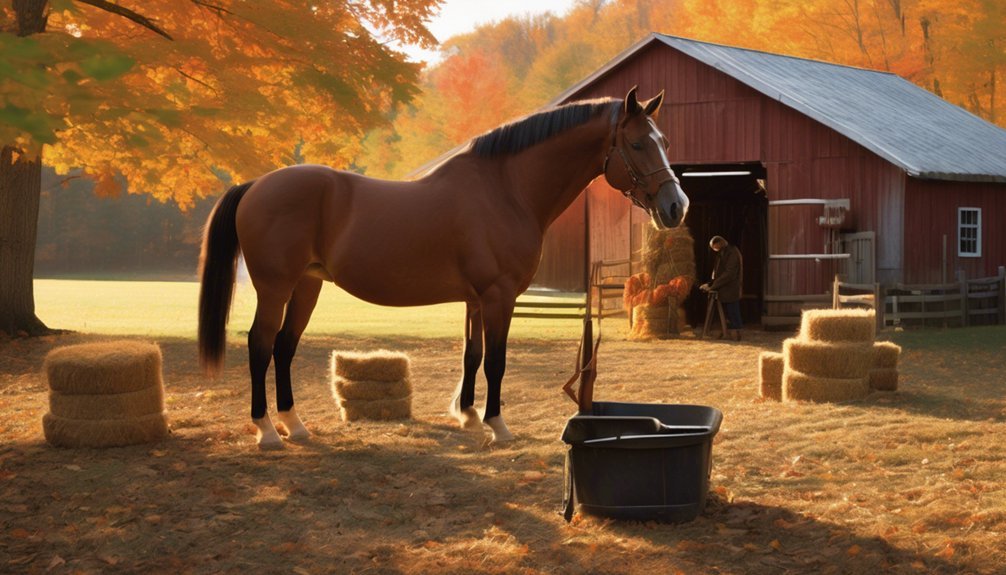
As the seasons change, your horse's grooming routine should adapt to the varying weather conditions and coat types. In winter, your horse's thick winter coat requires thorough brushing to remove dirt and debris, promoting warmth and comfort. When summer arrives, prepare for summer shedding by using a shedding blade or curry comb to help them shed their winter coat efficiently. This not only keeps them comfortable, but also strengthens your bond.
| Season | Grooming Focus | Tools Needed |
|---|---|---|
| Winter | Remove dirt & debris | Stiff brush, curry |
| Spring | Assist shedding | Shedding blade, comb |
| Summer | Maintain coat health | Soft brush, spray |
Adapting your routine keeps your horse healthy and happy!
Recognizing Skin Conditions and Health Issues
Even with a solid grooming routine, skin conditions can still arise, so it's important to regularly check your horse for any signs of health issues.
Pay close attention to areas like the mane, tail, and underbelly, where skin sensitivity can manifest.
Look for these common indicators of skin problems:
- Redness or swelling
- Unusual itching or rubbing
- Foul odor or discharge
- Scaly or flaky patches
Being proactive helps you catch common infections early, like rain rot or fungal issues.
If you notice any abnormalities, consult your vet for a proper diagnosis.
Involving Other Caregivers in the Routine
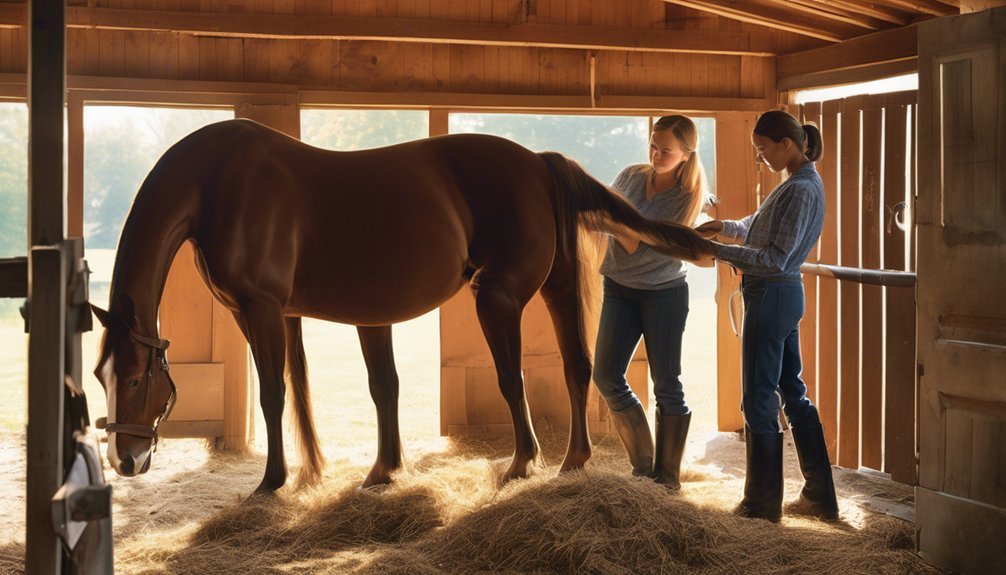
Many horse owners benefit from involving other caregivers in their grooming routine, creating a more efficient and enjoyable experience for both the horse and the humans.
Start by establishing clear communication strategies; discuss each person's caregiver responsibilities to ensure everyone knows their role. For instance, one can focus on brushing while another checks for injuries or skin issues.
Regular meetings can help address any concerns and keep everyone aligned. Make sure to share insights about your horse's preferences and quirks, fostering a deeper connection among caregivers.
Making Grooming Enjoyable for Your Horse
Creating a positive grooming experience for your horse not only enhances their well-being but also strengthens the bond between you two. To make grooming enjoyable, focus on incorporating grooming rewards and positive reinforcement. Start by choosing a calm environment and allowing your horse to adjust. Use gentle strokes and speak softly to create a relaxing atmosphere.
Here are some tips to enhance the experience:
- Offer your horse treats during and after grooming to reinforce good behavior.
- Use a variety of grooming tools to keep things interesting.
- Play soft music to soothe them while you work.
- Take breaks for scratches and affection, reinforcing your connection.
Frequently Asked Questions
How Can I Tell if My Horse Enjoys Grooming?
You can tell your horse enjoys grooming by observing its body language. If it relaxes, lowers its head, or leans into the grooming tools, it likely appreciates the attention and care you're providing.
What Should I Do if My Horse Resists Grooming?
When your horse pulls away like a stubborn cloud, it's crucial to identify resistance causes. Try positive reinforcement, rewarding them for calmness. Gradually introduce grooming, making it a comforting experience rather than a chore.
Can Grooming Help With My Horse's Anxiety?
Grooming can significantly help reduce your horse's anxiety. By regularly grooming, you foster trust and connection, which promotes relaxation. The grooming benefits extend beyond physical care; they create a calming routine that soothes both you and your horse.
How Often Should I Bathe My Horse?
Bathing your horse too often can strip natural oils, leaving their coat dull and dry. Generally, once a month is ideal, but adjust bath frequency based on your horse's coat condition and activity level.
Are There Specific Grooming Techniques for Different Horse Breeds?
Yes, there are specific grooming techniques for different horse breeds. Consider their breed characteristics when selecting grooming tools; for instance, a draft horse may need heavier brushes, while a thoroughbred benefits from softer, gentler tools.
Conclusion
By creating a personalized grooming routine, you not only keep your horse looking great but also enhance your bond. Regular grooming helps you spot potential health issues early, ensuring your horse stays in top shape. Isn't it rewarding to see how much your horse enjoys this time together? Embrace the process and adjust as needed, making it a consistent part of your care. With dedication, you'll foster a trusting relationship that benefits both you and your horse.





